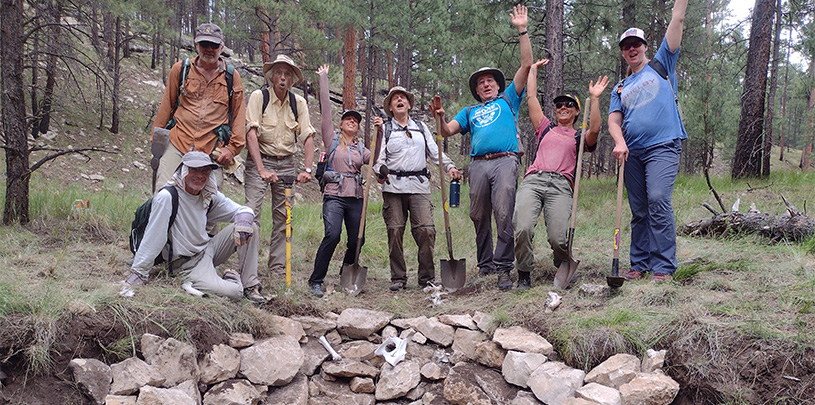
 by Lena Bain, Volunteer Associate
by Lena Bain, Volunteer Associate
“Oh look, a tree frog!” someone shouts.
Our small group of Grand Canyon Trust volunteers huddles around the bright green frog as it hops across damp pine needles at our camp. The daily monsoons have passed, and seeing the water-loving Arizona tree frog on the first day of our wetland restoration trip feels like a promising sign.
“I bet the critters are happy about this rain,” I remark.
The next morning, we will begin restoration work in Lockwood Draw, a seasonal stream with deeply eroded channels and struggling plant life in Coconino National Forest, on the southern edge of the Colorado Plateau in Arizona.
 Arizona tree frog.
Arizona tree frog.
Storms are becoming more sporadic and intense across the Southwest. They often bring unusually large amounts of rainfall all at once, worsening erosion in seasonal streams. As the climate changes, water sources like Lockwood Draw are essential for the health of the forest. They support native plants and wildlife and boost the forest’s resistance to drought.
But for Lockwood Draw to help the forest, it needs some care first. Stabilizing stream banks at Lockwood Draw will help plants take root and increase the surface water available to critters like the tree frog hopping through our camp.
 Volunteers strategically stack rocks.
Volunteers strategically stack rocks.
Improving conditions at Lockwood Draw over five days feels like a massive undertaking. Fortunately, there is a simple solution: rocks.
The next day we dive into our work with gusto. Jim, our volunteer expert on erosion control structures, gathers us around for a lesson. Lockwood Draw, like many other northern Arizona wetlands, has been trampled by cows, deer, and elk. Its banks are crumbling and its delicate grasses mown short. As a result, water rushes down its channel too quickly, and less moisture soaks into the soil. Without treatment, the wetland area around the stream dries up, which reduces habitat and contributes to parched forest conditions more conducive to massive fires.
Despite recent rains, the streambed at Lockwood Draw is currently dry, revealing scoured-bare dirt. Jim gingerly steps down into the dusty streambed and begins to outline a rock structure that will stabilize the eroding bank, slow the water, and give this section of the stream an opportunity to heal.
Occasionally calling for a particular rock, Jim skillfully positions each stone until he has created a small swimming pool. This rock basin, called a Zuni bowl, collects the water before allowing it to slowly exit over a lip at the bottom. Jim describes a few more rock configurations we can use to impede water, including: one rock dams, rock run downs, and media lunas. Each structure has its merits, depending on the type of erosion you’re working to fix.
With our new knowledge, we break into groups and move downstream. Deciding which method to deploy at each problem area is tricky, but Jim and the Forest Service hydrologist offer guidance. We feel like sweaty artists as we heave rocks into position and create functional sculptures in the forest stream. Every rock structure will slow the water, improving conditions not only at the immediate site, but for everything downstream as well. Over the course of the week, we build seven large rock structures, each one unique.
 One of the rock structures after a rain storm. DENNIS KRUSE
One of the rock structures after a rain storm. DENNIS KRUSE
The final night of our trip, a massive storm rolls across the landscape. Crashing into the Mogollon Rim, it unloads a deluge on our campsite. After a harrowing, lightening-filled night, we emerge from soaked tents thankful the storm passed without serious incident. Dennis and Roy, two of our volunteers, venture back down to Lockwood Draw to photograph our work.
When they arrive, they see evidence that a flash flood had raced down the draw during the night. But our rock structures are intact, having done exactly what they were designed to do — slow the water! Fresh dirt, pine duff, and leaves fill the small crevices between the rocks, the beginnings of natural grout that will cement our structures in place for years to come. Eventually plants will grow in as well, their root systems further strengthening the stream banks, allowing water to meander slowly and the meadow to flourish.
As 2024 draws to a close, we look back at five maps we created this year that give us hope for 2025.
Read MoreThe federal government will determine if the charismatic blue bird should be listed as threatened or endangered.
Read MoreWe can’t wait to meet you in a canyon, along a creek, or in the high alpine meadows of the Colorado Plateau.
Read More